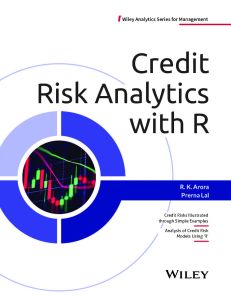Credit Risk Analytics with R
ISBN: 9789357461559
464 pages
For more information write to us at: acadmktg@wiley.com

Description
Credit risk analytics is a set of tools and techniques that enable lenders to take credit decisions and estimate the credit risk by predicting the credit behaviour of potential borrowers. Beginning with the fundamental concepts of credit risk analytics, this book offers in-depth insight into credit scoring models, probability of default (discrete time models and continuous time models) and modelling (exposures, recoveries, default correlations, and counterparty risk). Adopting a balanced strategy combining theoretical explanation and practical applications, the book demonstrates how you can build credit risk models using R and apply them into practice.
Preface
About the Authors
Chapter 1 Credit Risk Analytics
1.1 Introduction
1.2 Credit Risk
1.3 Credit Risk Analytics
1.4 Factors Driving Use of Credit Risk Analytics
1.5 Factors Affecting Credit Risk
1.6 Benefits of Credit Risk Analytics
1.7 Credit Risk Analytics Software
1.8 Application of Credit Risk Analytics to Credit Scoring
1.9 Current Challenges in Credit Risk Analytics
1.10 Career Options in Credit Risk Analytics
Chapter 2 Credit Scoring Models
2.1 Introduction
2.2 Techniques to Build Scorecards
2.3 Decision Trees
2.4 Logistic Regression versus Decision Trees
2.5 Other Classification Techniques
2.6 Credit Scoring for Retail Exposures
2.7 Credit Scoring for Non-Retail Exposures
2.8 Role of Big Data
2.9 Overruling of Scorecard
2.10 Applications of Credit Scoring
2.11 Limitations of Credit Scoring
2.12 Evaluation of a Scoring Model
Chapter 3 Probability of Default: Discrete Time Models
3.1 Introduction
3.2 Default Events
3.3 Conditional and Unconditional Default
3.4 Hazard Rate
3.5 Cumulative Default Probability
3.6 Risk-Neutral and Real-World Probabilities
3.7 Calculation of Default Probability Using Historical Data
3.8 Option Theoretic Approach
3.9 Default Probability (DP) Models
3.10 Migration Probabilities
3.11 Term Structure of Default Probability
3.12 Basel Requirements
Chapter 4 Probability of Default: Continuous Time Hazard Models
4.1 Introduction
4.2 Survival Analysis
4.3 Life Table Models
4.4 Kaplan–Meier (KM) Analysis
4.5 Cox Proportional Hazard (CPH) Model
4.6 Accelerated Failure Time (AFT) Models
4.7 Discrete Time Hazard Models versus Continuous Time Hazard Models
Chapter 5 Modelling Exposures at Default
5.1 Introduction
5.2 Exposure at Default (EAD)
5.3 Counterparty Credit Exposure
5.4 Basel Guidelines
5.5 EAD Modelling
Chapter 6 Modelling Recoveries and Loss Given Default
6.1 Introduction
6.2 Measures of Recovery
6.3 Determination of Recovery Rates
6.4 Factors Affecting Recovery Rates
6.5 Stochastic Recovery Rates
6.6 Estimation of LGD
6.7 Issues in Estimating LGD
6.8 Basel Guidelines
6.9 Sources of Recovery Data
Chapter 7 Modelling Credit Risk Correlations
7.1 Introduction
7.2 Sources of Dependence
7.3 Correlation Definition
7.4 Other Measures of Dependence
7.5 Factor Models of Correlation
7.6 Correlation Estimation by Credit Risk Models
7.7 Indirect and Direct Co-Dependence in Credit Risk Models
Chapter 8 Modelling Counterparty Credit Risk
8.1 Introduction
8.2 Credit Value Adjustment (CVA)
8.3 Expected Future Exposure in Interest Rate Swaps and Currency Swaps
8.4 Pricing CVA in Practice
8.5 Management of Counterparty Credit Risk
8.6 Counterparty Credit Risk Regulation
Chapter 9 Credit Value at Risk
9.1 Introduction
9.2 Exposure at Default
9.3 Loss Given Default
9.4 Credit Risk Correlations
9.5 Expected and Unexpected Loss
9.6 Credit Risk Models
9.7 Alternative Approaches
9.8 Basel Guidelines
9.9 Regulation under the Indian Law
Appendix A Exploratory Data Analysis
A.1 Introduction
A.2 Univariate Non-Graphical EDA
A.3 Univariate Graphical EDA
A.4 Multivariate Graphical EDA
A.5 Multivariate Non-Graphical EDA
A.6 Inferential Statistics
Appendix B Data Pre-Processing for Credit Risk Modelling
B.1 Sources of Data
B.2 Aggregation of Data
B.3 Sampling
B.4 Types of Data
B.5 Visual Exploration of Data
B.6 Descriptive Statistics
B.7 Dealing with Missing Values
B.8 Detection and Treatment of Outliers
B.9 Standardisation of Data
B.10 Categorisation
B.11 Coding Using Weights of Evidence
B.12 Variable Selection
B.13 Segmentation
B.14 Definition of Default
Appendix C Introduction to R
C.1 The R Environment
C.2 Download and Install R on Windows
C.3 Installing RStudio
C.4 Introduction to R Programming
C.5 Installing R Packages
Appendix D Guidance Note on Credit Risk Management
Chapter 1 Policy Framework
Chapter 2 Credit Rating Framework
Chapter 3 Credit Risk Models
Chapter 4 Portfolio Management and Risk Limits
Chapter 5 Managing Credit Risk in Inter-bank Exposure
Chapter 6 Credit Risk in Off-balance Sheet Exposures
Chapter 7 Country Risk
Chapter 8 Loan Review Mechanism/Credit Audit
Chapter 9 RAROC Pricing/Economic Profit
Chapter 10 New Capital Accord: Implications for Credit Risk Management

